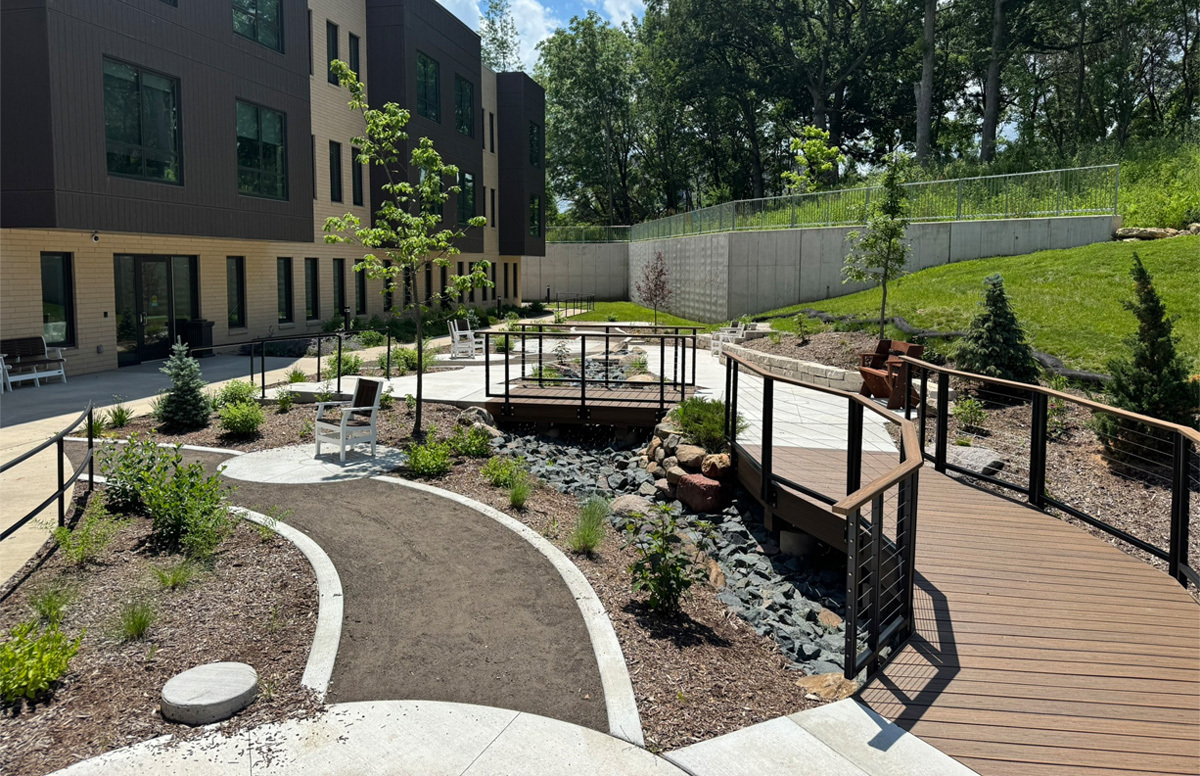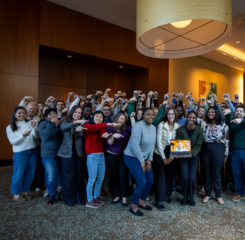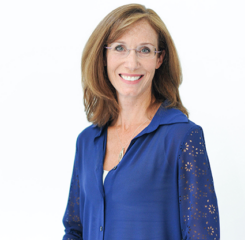The Peggy Lindberg Agility Park at the University Woods Campus of LeadingAge member Oakwood Village, a two-site life plan provider in Madison, WI, is at first glance a pleasant outdoor space for residents to relax and watch the butterflies attracted by plants curated for that purpose. But careful observation after just a few minutes on the grounds, which incorporate concrete, gravel, and other surfaces, reveals the park’s other function: It is also an innovative therapy course designed for older adults undergoing physical therapy (PT) and rehabilitation after surgery, injury, or illness.
“The benefit to this is that it’s a pretty, functional, safe, and structured environment,” but it also offers a variety of experiences, said Kristin Lefel, Oakwood Village’s director of therapy & fitness. “And all the while you get the medicine of the outdoors and fresh air.”
Connected to University Woods’ two-year-old Hebron Oaks Skilled Nursing and Rehabilitation Center, the park is available to any resident for leisure, and is also a resource for Hebron Oaks’ rehab patients and staff, thanks to unique features developed by Oakwood Village’s rehabilitation team in collaboration with park designers Eppstein Uhen Architects and Saiki Design, a landscape architecture firm.
Completed in fall 2024, the park is named after the late Margaret “Peggy” Lindberg, a long-time Oakwood Village resident and a former rehab patient, whose foundation provided funding for the park’s design and construction when approached by David Mossner, executive director of the Oakwood Foundation.
Design with Rehab in Mind
The park is a boon to rehab, according to Lefel, because it offers therapists options that are more difficult to recreate indoors.
Lefel and her colleagues’ expertise ensured the park’s therapeutic functionality. Rest areas all have concrete surfaces (the easiest to navigate for those rehabbing lower-body issues), the furniture has proper seat heights (“firm at the 19-inch mark”), and the outdoor steps are the proper seven-inch height to match modern building codes.
In addition, pathways feature six different surfaces and gentle elevation changes, Lefel said, chosen to facilitate rehab: Concrete is the easiest—and therefore the first—surface for a new patient. Wooden planks offer a little more texture, Lefel said, but are also “a sturdy, stable surface.” Next is the rubber aggregate, a smooth surface with a feel similar to walking on grass. Attention is paid to navigating the transitions between surfaces, for instance, placing the rubber aggregate next to concrete.
“Easily, the most challenging are the sand and then the gravel. You have to have a lot of ankle stability to maneuver those surfaces,” Lefel said, noting that they are not appropriate for patients using walkers or wheelchairs. There is also one spot with a giant stone as part of a path, to give patients a feel for that surface.
“We use the [outdoor] space for what we call ‘gait variance’ training, because our gym is just a wide-open space, and you’re not going to fall off of anything,” said Lefel, but the outdoor paths help patients learn to control their gait. She also said the seven-inch outdoor stairs offer a more realistic experience than the smaller rehab stairs used indoors, and the sand and gravel surfaces available outside can be difficult to simulate indoors.
She estimates that the park is visited by 30 to 50 people each week, including those in rehab as well as residents who come simply to enjoy the environment.
“The biggest compliment you can get,” Lefel added, referring to the gift from the park’s namesake, Peggy Lindberg, “is that someone you’ve served in the past [wants] to give back to your department. Our entire team still gets emotional about it.”
Photo of the Peggy Lindberg Agility Park courtesy of Oakwood Village.
This story originated in the LeadingAge Story Collector, powered by Greystone—a great place to share your organization’s innovations. Submit your story now.

 Shutdown Week Three: Impact of Ongoing Closure on Affordable Housing
Shutdown Week Three: Impact of Ongoing Closure on Affordable Housing


